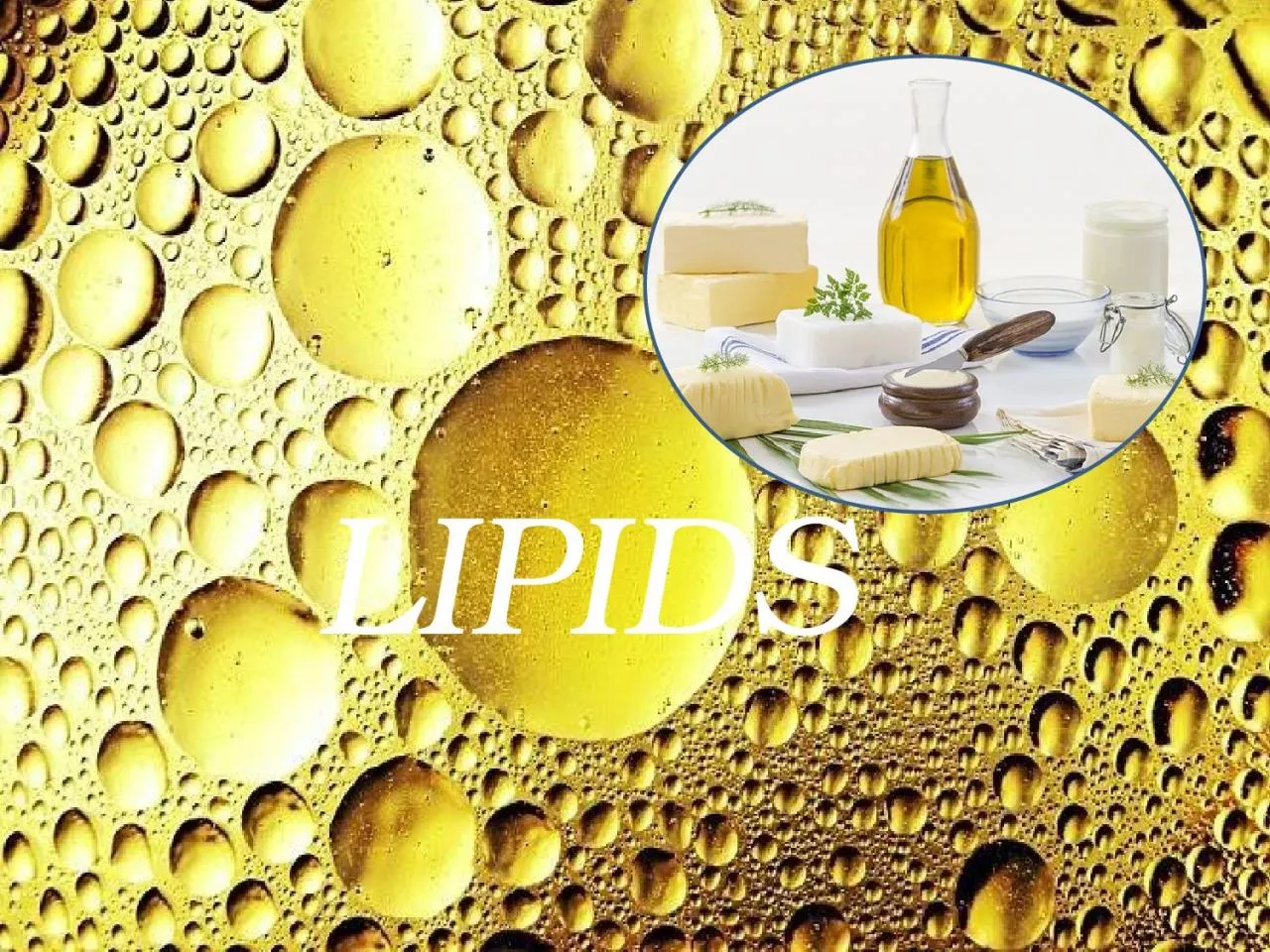

Lipids are a group of naturally occurring substances include a diverse group of organic compounds including fats oils hormones and certain components of membranes phospholipids All of these substances relatively insoluble in water but soluble in organic solvents like chloroform ID: 1043140
Download Presentation The PPT/PDF document "LIPIDS Definition" is the property of its rightful owner. Permission is granted to download and print the materials on this web site for personal, non-commercial use only, and to display it on your personal computer provided you do not modify the materials and that you retain all copyright notices contained in the materials. By downloading content from our website, you accept the terms of this agreement.
1. LIPIDS
2. DefinitionLipids: are a group of naturally occurring substances include a diverse group of organic compounds including fats, oils, hormones, and certain components of membranes (phospholipids). All of these substances relatively insoluble in water but soluble in organic solvents like: chloroform, ether and benzene.In the human body, most of these molecules can be synthesized in the liver and a specific parts of body and can be found in oil, butter, whole milk, cheese, fried foods and also in some red meats.
3. Lipids Properties & FunctionsLipids are a family of organic compounds, composed of fats and oils. Below are some important characteristics of Lipids.Lipids are1.Oily or greasy nonpolar molecules, stored in the adipose tissue of the body.2. A heterogeneous group of compounds, mainly composed of hydrocarbon chains.3. Energy-rich organic molecules, which provide energy for different life processes.4. A class of compounds characterised by their solubility in nonpolar solvents and insolubility in water.5. Significant in biological systems as they form a mechanical barrier dividing a cell from the external environment known as the cell membrane.Functions of lipids Storage form of energy.Structural component of cell membrane.Precursor of many steroid hormones as: estrogen, vitamin D.Protection of internal organs.
4. Types of lipids Lipids with fatty acids: Waxes.Fats and oils (tri-glycerides).Phospholipids.Sphingolipids.Lipids without fatty acids:Steroids.Lipids derivatives.
5. Classification of LipidsSimple Lipids:Fatty acids with alcohol (glycerol or alcohol other than glycerol) attached to each other by ester bonds.If alcohol is glycerol Fats and Oils.Oils: Triglycerides rich in unsaturated fatty acids are generally liquid at room temperature.Fats: Triglycerides rich in saturated fatty acids are generally semisolids or solids at room temperature.If alcohol is other than glycerol Waxes.
6. Classification of lipidsFatty acidFatty acids are carboxylic acids that are structural components of fats, oils, and all other categories of lipids.They usually contain an even number of carbon atoms (typically 12–20), are generally unbranched, and can be classified by the presence and number of carbon-to-carbon double bonds. Saturated fatty acids contain no carbon-to-carbon double bonds.Monounsaturated fatty acids contain one carbon-to-carbon double bond.Polyunsaturated fatty acids contain two or more carbon-to-carbon double bonds.
7. Conjugated Lipids: If hydrolysis: gives fatty acids with alcohol and containing additional [prosthetic] groups.Phospholipids : contain a phosphoric acid molecule and a fat molecule.Fatty acid + Alcohol + Phosphoric acid.Glycolipid : contain a carbohydrate and a fat molecule.Fatty acid + Alcohol + Carbohydrate.Sulfolipids : contain a sulfate radical and a fat molecule.Fatty acid + Alcohol + sulfate.Lipoprotein : contain a Protein and a fat molecule.Fatty acid + Alcohol + protein.
8. The Qualitative Analysis Of LipidsThe qualitative analysis of lipids is an analytical method that detects lipids by the characteristic change in the sample’s color.There are several methods used for the qualitative analysis of lipids and their components.Solubility Test: detects lipid solubility in various solvents to check whether it is miscible or immiscible in polar or non-polar solvents.Principles:it is based on the property of lipid solubility in different solvents. Lipids are readily miscible in non-polar solvents like chloroform, partially soluble in a polar solvent like ethanol, and immiscible in a polar solvent like water.The test is the preliminary test that detects the presence of all lipids.
9. Method :Take 4 test tubes in one of them put 2 ml of water and in the other put 2ml of Ethanol, chloroform or hexane. In each test tubes add 5 drops of oil , mix and allow them to stand. Oil and water separate quickly and where as a clear solution is formed in the other test tube . this shows that oil is in soluble in water and soluble in organic solvents.•Positive result: Lipids are soluble in a non-polar solvent, i.e. chloroform, and partially soluble in ethanol which can solubilize upon heating.•Negative result: Lipids are insoluble in a polar solvent, i.e. water.
10. Saponification TestIt is based on the saponification reaction.Principle:the triglycerides of lipids can react with an alkali NaOH to produce soap and glycerol in the presence of ethanol. This reaction is also known as alkaline hydrolysis of esters.
11. Method:1. Take a sample of lipids in a test tube.2. Then, add strong alkali NaOH.3. Then, boil the solution in a water bath for 5 minutes.4. At last, add ethanol.5. Observe the test tube for the appearance of froth.•Positive result: Froth appears in the test tube.•Negative result: Froth does not appear in the test tube.
12. Iodine Test Test to differentiate between lipids contain saturated fatty acid or unsaturated fatty acids PrincipleUnsaturated fatty acid can add halogens (iodine) at the double bonds to form halogenated derivatives , while saturated fatty acids cannot. Oil contain a higher percent of unsaturated fatty acids than solid fat, so oils can react with more iodine.Method:1. Take 3 ml of chloroform and 3 ml of iodine reagent in a beaker, giving a pink color to the solution.2. Add the lipid sample drop by drop and shake vigorously, until the pink color disappears.3. Count the number of drops added to chloroform and Huble’s iodine solution until the pink color disappears. The number of drops determines the taking up of iodine by the unsaturated fatty acid of lipids.
13.
14. •Positive result: The semi-brown color will disappear with the addition of unsaturated fatty acids.•Negative result: The pink color will not disappear.